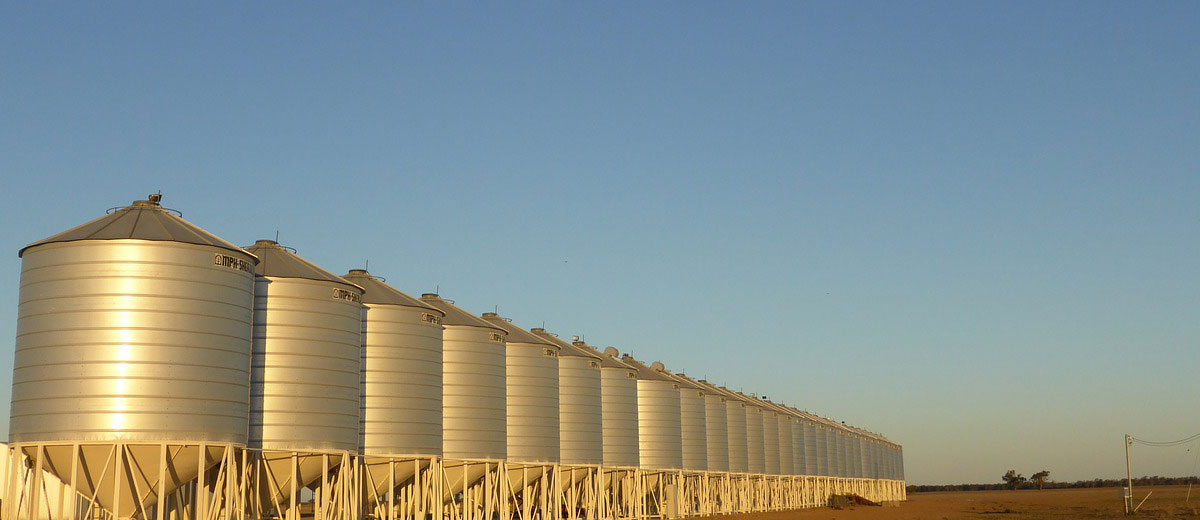
Grain Drying and Storage
By Dunling Wang, PhD, PAg, Provincial Specialist, Alternative Cropping Systems and Cory Jacob, MSc, PAg, Provincial Specialist, Oilseed Crops, Regina
The moisture content and temperature of grain are two important factors for long term storage. Grain stored with a high moisture content or temperature is at risk of heating, causing downgrading and financial loss. Natural Air Grain Drying (NAGD) and aeration are the two main ways to address this risk. Aeration uses low air flow rates between 0.1 and 0.2 cubic feet per minute per bushel (cfm/bu.) to cool down the grain mass or to make the temperature of the grain uniform. In contrast, the goal of NAGD is to remove moisture. Depending on the crop type, NAGD requires higher air flow rates of one to two cfm/bu.
In NAGD systems, when air with low relative humidity moves through the grain mass it takes on moisture from the grain and exits through the lid. Dr. Ron Palmer from the University of Regina has conducted tests using NAGD and concluded that using cool air (temperature lower than the grain) is more effective than a warm air (temperature higher than the grain). When the cool air passes through warm grain, it warms and its water holding capacity increases. Increased water holding capacity increases the airs ability to absorb moisture from the grain. Based on research results, he made several important suggestions:
- Fans should be turned on as soon as fresh grain is loaded into the bin because the first day of fan operation results in a large amount of water being removed and a big drop in temperature. The drop in grain temperature greatly reduces risks of grain spoilage.
- Maintaining air flow of 0.5 cfm/bu. is adequate for natural air drying without supplemental heat.
- Running the fan only at night is not only efficient in removing moisture, but also effective in keeping the grain cool. Turn the fan on when the yard light is on in the evening and shut it off at 9 a.m. the next morning.
- Activate the fan when the grain temperature is higher than outside air by 2 C. This method requires two temperature sensors, one in the grain and the other outside. As the method always keeps the grain cool, it is the most effective in preventing spoilage. However, in cases of high relative humidity in outside air or when the grain is close to dry, it can lead to increased grain moisture content.
When the grain and air temperature drop below 5 C, supplemental heat is needed to remove moisture from the grain. Hotter air through supplemental heat dries grain faster, but it can potentially cause grain spoilage when there is not enough airflow to take moisture out. Research suggests that at least 0.75 cfm/bu. airflow should be maintained when supplemental heat is continuously provided. In general, a 75,000 BTU heater with a 3-HP fan is appropriate for a 5,000-bushel bin. However, running supplemental heat continuously is not recommended, as it raises the temperature of the grain and decreases drying efficiency. It becomes more effective to switch off the heater when the bottom half of the bin reaches 25 C and running natural air to cool off the grain to about 10 C. Repeat this warm and cool air cycle.
Tough grain is at a greater risk of pest and fungal growth. Producers may use a dryer when dealing with damp grain. A dryer provides extra drying capacity through high temperature and high airflow. But, high temperature and quick drying can cause damage to the grain, cracks in seed coats and increases the risk of fire. Producers who use a grain dryer should follow the guidelines developed by the Canadian Grain Commission (Table 1).
Table 1 Maximum grain drying temperature (C)
Crop Seed Commercial use Feed Wheat 60 65 80-100 Oats 50 60 80-100 Barley 45 55 80-100 Rye 45 60 80-100 Lentils 45 45 80-100 Flax 45 80 80-100 Pea 45 70 80-100 Canola 45 82 – Mustard 45 60 – Buckwheat 45 45 – Once the grain is dried, it should be cooled within 5 C of the ambient air temperature to prevent condensation. Aeration may be required when the air temperature drops to ensure the cooling air reaches potential condensation spots. Monitor the grain temperature at least once a month, and keep the grain cool during storage.
For the latest information and for more updates on everything Kindersley ‘Like’ the Kindersley Social Facebook page below…








































